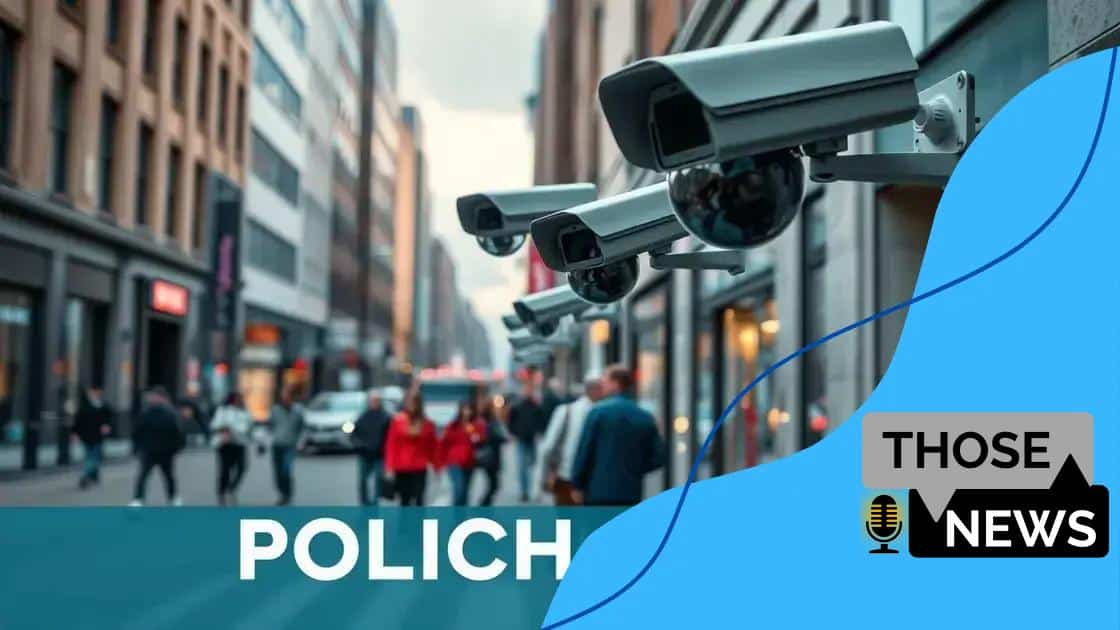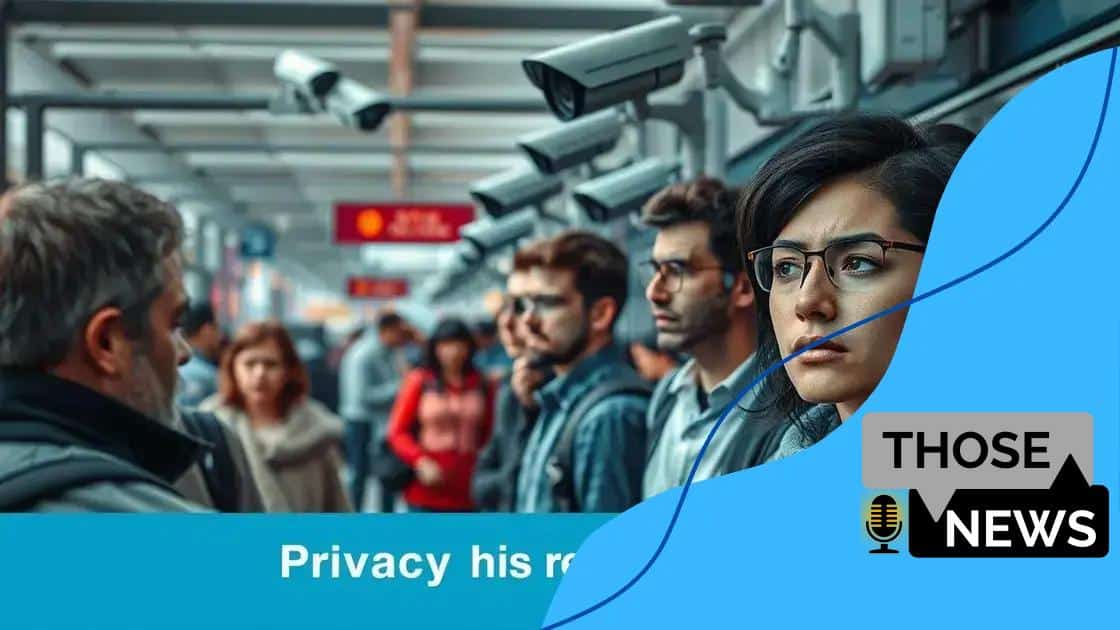The role of facial recognition in enhancing public safety

The role of facial recognition in enhancing public safety includes improving crime prevention, streamlining emergency responses, and fostering community trust while addressing privacy concerns and ethical implications.
The role of facial recognition in enhancing public safety is a topic that continues to spark debate and interest. How does this technology affect our daily lives and safety?
Understanding facial recognition technology
Facial recognition technology is quickly changing how we perceive safety and security. By using algorithms, this technology can identify people by analyzing their facial features. With growing concerns about safety, it’s crucial to understand how this technology works and its implications.
How facial recognition works
At its core, facial recognition technology compares a live capture or digital image of a person’s face with a database of known faces. The process involves several steps:
- Detection: Locating a face in an image.
- Analysis: Measuring facial features and creating a unique template.
- Matching: Comparing the template against stored data.
This system is effective in various contexts, including law enforcement and security. However, it comes with challenges that require attention.
Benefits of facial recognition technology
The advantages of using facial recognition technology are vast. Some of the key benefits include:
- Enhanced security measures in public spaces.
- Faster identification of suspects in criminal cases.
- Improved efficiency in access control systems.
While these benefits contribute to public safety, it’s vital to consider the potential drawbacks. For instance, false positives can lead to wrongful accusations, raising significant ethical questions.
Understanding facial recognition technology also involves recognizing its place in our daily lives. Many smartphones now utilize this feature to provide secure access. As technology evolves, its applications will expand further.
Challenges and concerns
Despite its benefits, facial recognition technology poses serious concerns, particularly regarding privacy:
- Unregulated use can lead to surveillance overreach.
- The risk of data breaches increases with larger databases.
- Bias in algorithms can disproportionately affect certain groups.
A strategic balance between implementing facial recognition technology and protecting individual rights is crucial. Public dialogue and policy development are essential steps in addressing these challenges.
How facial recognition improves crime prevention
Facial recognition plays a critical role in crime prevention, enhancing security in various environments. With its ability to quickly identify suspects, law enforcement agencies are increasingly adopting this technology.
Speed and efficiency
One major advantage of facial recognition technology is speed. Officers can scan crowds in real-time, identifying criminals almost instantly. This capability enables rapid responses and can deter criminal activity.
- Facial recognition systems integrate with surveillance cameras.
- They reduce the time it takes to match faces in databases.
- These systems operate efficiently under challenging conditions, such as low light.
This technology is particularly useful during large events where many people gather. By monitoring these crowds, security agencies can prevent incidents before they escalate.
Deterrence of criminal activity
Another significant impact of facial recognition is its ability to deter crime. When potential criminals know they’re being watched, they may think twice before acting. The mere presence of cameras equipped with this technology can create a safer environment.
- Increased surveillance leads to lower crime rates.
- Visible facial recognition signage can enhance deterrent effects.
- Collaboration with local businesses aids in community safety.
Moreover, successful identification of repeat offenders can lead to quicker interventions by authorities, ultimately reducing crime levels.
While the technology offers numerous benefits, balancing these advantages with privacy concerns is crucial. Addressing ethical questions around surveillance helps build public trust.
Privacy concerns surrounding facial recognition

As facial recognition technology becomes more widespread, it raises critical privacy concerns. Many individuals worry about how their personal information is used and whether they are being monitored without consent.
Invasion of privacy
The potential for government surveillance can cause unease among citizens. People may feel that they are being watched in public spaces, leading to a sense of invasion. This constant monitoring can discourage free expression and limit people’s comfort in participating in public life.
- Facial recognition can track individuals without their knowledge.
- Public spaces can turn into surveillance zones.
- It may create a chilling effect on free speech.
These concerns require a thoughtful approach to legislation and the ethics of using facial recognition technology.
Data security risks
Another major issue associated with facial recognition is data security. Hackers can target databases that store facial images and personal information. When sensitive data is compromised, it can lead to identity theft and other crimes.
- Data breaches can expose millions of records.
- Weak security measures increase vulnerability.
- Managing data responsibly is crucial for user trust.
Organizations must implement strong security protocols to protect this data, ensuring the privacy of individuals is safeguarded.
Moreover, the use of biased algorithms can further amplify existing inequalities. If facial recognition systems have not been trained on diverse datasets, they risk misidentifying certain groups more frequently, leading to unjust outcomes. Ongoing discussions about the ethical use of technology are essential to navigate these challenges.
Real-world applications of facial recognition
Facial recognition technology is being used in many real-world applications, enhancing security and convenience in various fields. The most prominent use is within law enforcement, where it helps identify suspects quickly and accurately.
Law enforcement and security
Police departments worldwide utilize facial recognition systems to match surveillance footage against databases of known criminals. This technology aids in solving cases more efficiently. Law enforcement can:
- Quickly identify criminal suspects in public areas.
- Enhance the safety of large gatherings by monitoring crowds.
- Assist in locating missing persons through recognition algorithms.
These applications show how facial recognition can play a vital role in public safety.
Retail and customer experience
In the retail sector, businesses use facial recognition to improve customer experiences. Stores implement systems to recognize loyal customers, allowing for tailored services. Retailers can:
- Monitor foot traffic and customer behavior.
- Automatically greet returning customers by name.
- Analyze shopping patterns for better inventory management.
This not only enhances the shopping experience but also increases overall sales.
Another significant application is in the field of banking. Financial institutions are adopting facial recognition to enhance security measures. Customers can use their faces to access accounts, adding a layer of security beyond traditional passwords. This technology helps reduce fraud and provides quicker access to banking services.
Healthcare and patient identification
Facial recognition is also making waves in healthcare. Hospitals are implementing the technology to identify patients quickly, ensuring accurate records. This can help:
- Reduce waiting times for patient check-ins.
- Prevent identity theft in medical records.
- Enhance safety by monitoring access to sensitive areas.
As you can see, the applications of facial recognition are vast and varied, with the potential to change how we interact with technology in everyday situations. The technology continues to evolve, making it essential to remain aware of its implications.
Future trends in public safety technology
The future of public safety technology is bright, with innovations promising to enhance security and improve response times. As technology advances, we can expect to see significant changes in how we protect communities.
Integration of artificial intelligence
One major trend is the integration of artificial intelligence (AI) with traditional safety measures. AI can analyze vast amounts of data in real-time, which helps identify potential threats faster. This integration allows for:
- Improved situational awareness for law enforcement.
- Predictive policing that anticipates crime hotspots.
- Automated alerts when suspicious behavior is detected.
These advancements make it easier for authorities to deploy resources effectively and prevent crime before it happens.
Smart city technology
Another trend is the development of smart city technologies. Cities are adopting smart sensors and connected devices to monitor public spaces. These technologies can:
- Enhance surveillance systems with video analytics.
- Streamline emergency responses through real-time data sharing.
- Facilitate better traffic management to reduce accidents.
By utilizing these systems, cities can create safer environments for their residents.
Moreover, advancements in facial recognition and biometric analytics will continue to evolve. Increased accuracy and reliability help ensure better identification methods in public spaces. However, as these technologies grow, so do the discussions around ethical implications and privacy concerns.
Community engagement and transparency
Future trends also include a focus on community engagement. Law enforcement agencies are recognizing the importance of building trust with the public. Utilizing technology to enhance transparency can improve community relations. This can be achieved through:
- Providing access to crime data for citizens.
- Using platforms for community feedback.
- Implementing open dialogues about safety measures.
Engaging communities in conversations about public safety helps build rapport and ensures that technology serves the needs of everyone effectively.
FAQ – Frequently Asked Questions about Facial Recognition Technology and Public Safety
How does facial recognition enhance public safety?
Facial recognition improves public safety by quickly identifying suspects, preventing crime, and enhancing security measures in various environments.
What are the main privacy concerns regarding facial recognition?
Privacy concerns include the risk of surveillance without consent, potential data breaches, and bias in facial recognition algorithms.
What role does community engagement play in facial recognition use?
Community engagement helps build trust between law enforcement and the public, ensuring that technology is used responsibly and meets community needs.
What are some future trends in public safety technology?
Future trends include the integration of AI, development of smart city technologies, and increased focus on transparency and community involvement.





